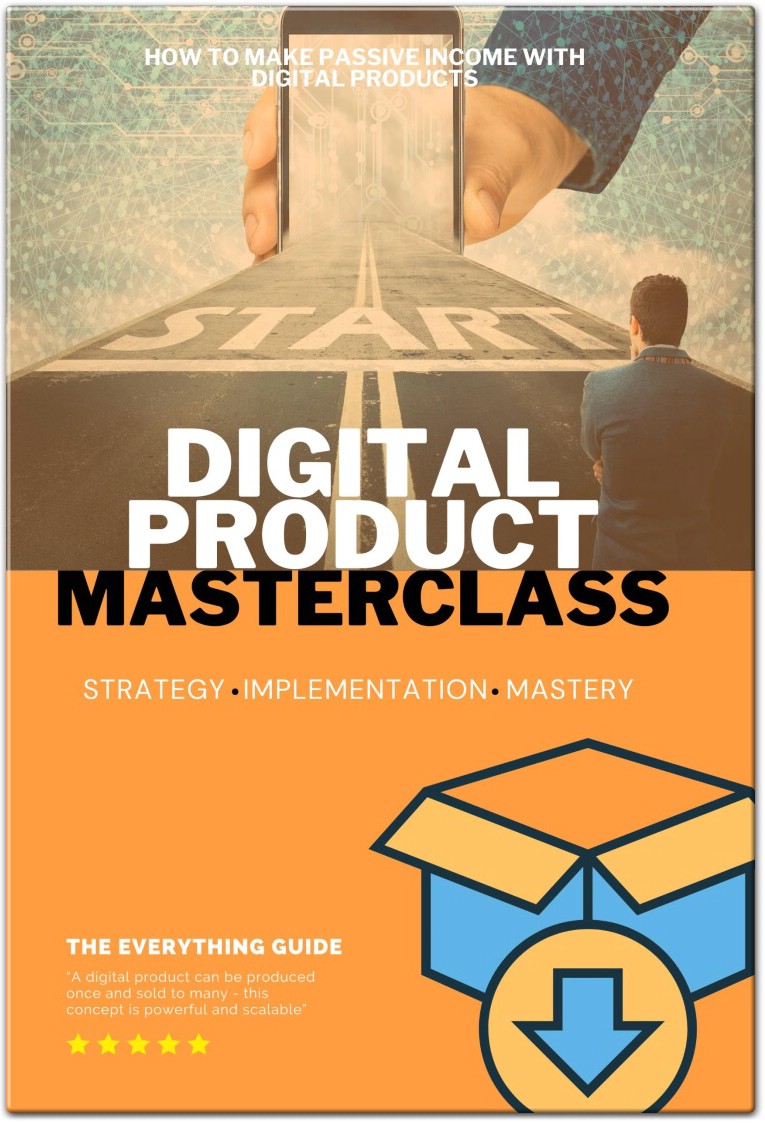
Digital Product Strategy is everything you need to know about how to create and sell profitable digital products online.
You will discover:
Why selling digital products online is the best business in the world!
How solving problems is the key to profitable products
How you can use a USP and branding to build a long-term successful 6 figure business.
Superfast product creation methods where you could have a product created ready to sell in 24 hours or less!
Why your PST is so important when selling your digital products.
Why your mindset will be the most important role in having success online.
How to become a digital product master and become part of the elite – you can practically write your paycheck when you learn this!
Book Summary Contents
- 1 Digital Product Strategy Implementation Mastery Strategy – Implementation – Mastery Book Details
- 2 Digital Product Strategy Implementation Mastery Strategy – Implementation – Mastery Table Of Contents
- 3 Digital Product Strategy Book Summary
- 3.1 Chapter 1: Introduction to Digital Product Mastery
- 3.2 Chapter 2: Identifying Profitable Niches
- 3.3 Chapter 3: Developing Your Unique Value Proposition (UVP)
- 3.4 Chapter 4: Creating High-Quality Digital Products
- 3.5 Chapter 5: Building an Engaging Online Course
- 3.6 Chapter 6: Setting Up Your Sales Funnel
- 3.7 Chapter 7: Marketing and Promoting Your Digital Products
- 3.8 Chapter 8: Automating Sales and Customer Support
- 3.9 Chapter 9: Scaling Your Digital Product Business
- 3.10 Chapter 10: Sustaining Long-Term Passive Income
- 4 About the Author:
- 5 Get Your Copy Of The Book: Digital Product Strategy Implementation Mastery Strategy – Implementation – Mastery
Digital Product Strategy Implementation Mastery Strategy – Implementation – Mastery Book Details
| Title | Digital Product Strategy Implementation Mastery Strategy – Implementation – Mastery |
|---|---|
| Pages | 63 |
| Size | 2.17 MB |
| Genre | Marketing, Digitale Marketing |
| License | Paid |
Digital Product Strategy Implementation Mastery Strategy – Implementation – Mastery Table Of Contents
Chapter 1: Introduction to Digital Product Mastery
Chapter 2: Identifying Profitable Niches
Chapter 3: Developing Your Unique Value Proposition
Chapter 4: Creating High-Quality Digital Products
Chapter 5: Building an Engaging Online Course
Chapter 6: Setting Up Your Sales Funnel
Chapter 7: Marketing and Promoting Your Digital Products
Chapter 8: Automating Sales and Customer Support
Chapter 9: Scaling Your Digital Product Business
Chapter 10: Sustaining Long-Term Passive Income
Digital Product Strategy Book Summary
Chapter 1: Introduction to Digital Product Mastery
Welcome to the journey of mastering digital products and generating passive income. In this chapter, we’ll introduce the concept of digital products, their benefits, and help set clear goals to ensure your success.
What Are Digital Products?
Digital products are intangible assets that can be sold and distributed online. Unlike physical products, they can be created once and sold repeatedly without inventory or shipping. Examples include eBooks, online courses, software, and digital art. The key advantage of digital products is scalability, with minimal overhead costs.
The Rise of Digital Products
The market for digital products has grown significantly due to technology advancements and the increasing demand for online solutions. Consumers benefit from instant access to eBooks, courses, and software, revolutionizing how we consume content.
Benefits of Creating Digital Products
- Scalability: Create once, sell infinitely with no extra production costs.
- Flexibility: Easily update and improve products.
- Global Reach: Sell to a worldwide audience online.
- Passive Income: Generate revenue automatically after initial setup.
- Low Overhead Costs: No need for manufacturing or shipping.
Setting Your Goals and Expectations
- Define Your Purpose: Understand why you want to create digital products, whether for income or to share knowledge.
- Set Achievable Goals: Break down long-term objectives into smaller tasks.
- Understand the Commitment: Be ready to invest time and effort.
- Embrace Continuous Learning: Keep up with digital trends to stay competitive.
The Digital Product Creation Process
- Research and Planning: Identify a niche and your target audience.
- Content Creation: Develop valuable content.
- Design and Packaging: Create visually appealing products.
- Sales and Marketing: Set up a sales funnel and marketing strategies.
- Automation and Support: Use tools to automate processes.
- Continuous Improvement: Gather customer feedback and make improvements.
Chapter 2: Identifying Profitable Niches
A profitable niche is essential for creating successful digital products. In this chapter, we’ll explore how to identify a niche, understand your target audience, and evaluate competition and demand.
Understanding Market Niches
A niche is a specific, targetable portion of a broader market. Focusing on a niche allows you to cater to specific needs and create relevant, valuable products, leading to higher conversions.
Researching Market Trends
Use tools like Google Trends, social media, online communities, and industry reports to research current trends and identify profitable opportunities.
Finding Your Target Audience
Define your target audience by researching demographics (age, income, location) and psychographics (interests, values, behavior). Surveys and customer personas help refine product ideas based on real feedback.
Evaluating Competition and Demand
Evaluate your niche by researching keyword trends, analyzing competitors, and estimating market size. A good balance of demand and manageable competition is key.
Refining Your Niche
Narrow down your niche by specializing, solving a specific problem, or combining interests. Test your ideas with a small audience to validate your niche before fully committing.
Identifying a profitable niche is a crucial step in building a successful digital product business. By conducting thorough research and understanding your audience’s needs, you can choose a niche that leads to long-term growth and profitability.
Chapter 3: Developing Your Unique Value Proposition (UVP)
Your UVP sets your product apart and gives customers a reason to choose it. In this chapter, you’ll learn how to craft a compelling UVP by understanding customer needs, differentiating your product, and communicating its benefits effectively.
Understanding Customer Needs
To create a UVP that resonates, first understand your customer’s pain points and desires. Conduct surveys, analyze feedback, and create customer personas to gather insights into what they value and need.
Differentiating Your Product
Identify what makes your product unique. Highlight distinct features, quality, customer experience, or a compelling brand story. Pricing that reflects the product’s value can also be a differentiator.
Crafting Your UVP
A strong UVP should be clear and concise:
- Headline: A simple benefit-driven statement.
- Subheadline: Briefly explain what your product is and who it’s for.
- Key Benefits: Use bullet points to list product advantages.
- Visual Elements: Include visuals like images or icons to enhance the message.
- Call to Action: Direct customers on the next step.
Communicating Your UVP
Make sure your UVP is prominent on your website, emails, social media, and advertising. Train your customer support and sales teams to communicate the UVP consistently.
A well-crafted UVP builds customer loyalty and differentiates your product in the market.
Chapter 4: Creating High-Quality Digital Products
Creating high-quality digital products is essential for a successful online business. This chapter explores the various types of digital products, tools for product creation, and best practices for developing engaging content.
Types of Digital Products
Digital products come in various formats, each with unique benefits:
- eBooks: Digital books covering diverse topics, suitable for knowledge sharing and storytelling.
- Online Courses: Structured educational programs delivered online, including videos, quizzes, and discussions.
- Software and Apps: Tools solving specific user problems, ranging from simple to complex applications.
- Digital Art and Graphics: Visual assets used by creators, including illustrations and templates.
- Music and Audio Files: Digital sound files for multimedia projects, catering to musicians and content creators.
- Templates and Tools: Pre-designed documents and presentations that save users time.
- Membership Sites: Platforms offering exclusive content for a recurring fee, providing ongoing value and income.
Tools and Resources for Product Creation
To create high-quality digital products, various tools are essential:
- Content Creation Tools:
- Writing: Microsoft Word, Google Docs, Scrivener for written content.
- Design: Adobe Photoshop, Illustrator, and Canva for visuals.
- Video Production: Adobe Premiere Pro, and Final Cut Pro for course videos.
- Course Creation Platforms: Teachable, Udemy, and others for hosting and selling online courses.
- Software Development Tools: Visual Studio, Xcode, and Android Studio for app development.
- Audio Production Tools: Audacity and GarageBand for audio content.
- Distribution Platforms: Amazon KDP for eBooks, Gumroad for downloads.
Best Practices for Developing High-Quality Content
Creating valuable content involves:
- Understanding Your Audience: Tailor content to meet audience needs.
- Planning and Structuring: Organize content logically and create a syllabus for courses.
- Focusing on Quality: Ensure high standards for visuals and writing.
- Providing Value: Deliver actionable insights and practical tips.
- Engaging Your Audience: Use interactive elements and relatable examples.
- Testing and Refining: Gather user feedback to improve content.
- Staying Updated: Keep content relevant with ongoing updates.
Ensuring Professional Presentation
To enhance perceived value:
- Branding: Maintain consistent branding elements.
- Design: Invest in professional design for visual appeal.
- User Experience: Ensure easy navigation and access to materials.
- Packaging: Provide clear instructions for downloadable products.
Creating high-quality digital products is crucial for establishing a successful online business, emphasizing quality, value, and professional presentation.
Chapter 5: Building an Engaging Online Course
Creating an engaging online course allows you to share expertise and generate passive income. This chapter covers structuring course content, producing high-quality videos, and incorporating interactive elements.
Structuring Your Course Content
A well-structured course is key to effective learning:
- Define Learning Objectives: Identify key outcomes for students.
- Create a Course Outline: Break down the course into modules and lessons.
- Chunk Content: Divide content into manageable segments for better retention.
- Sequence Lessons Logically: Arrange lessons to build knowledge incrementally.
- Include Summaries: Reinforce learning with summaries at the end of each module.
Recording and Editing Videos
High-quality videos are essential:
- Set Up Your Recording Space: Choose a quiet, well-lit area.
- Script Your Lessons: Outline key points for clarity.
- Engage with the Camera: Maintain eye contact and use body language.
- Use Visual Aids: Enhance understanding with slides and graphics.
- Edit for Clarity: Polish videos with editing software.
Creating Interactive and Valuable Course Materials
Include interactive elements to enhance engagement:
- Quizzes and Assessments: Test understanding and reinforce learning.
- Assignments and Projects: Apply knowledge in real-world scenarios.
- Discussion Forums: Foster community and collaborative learning.
- Downloadable Resources: Offer worksheets and additional materials.
- Live Sessions: Host webinars for real-time interaction.
Ensuring Accessibility and Inclusivity
Make your course accessible to all:
- Closed Captions and Transcripts: Provide text for video content.
- Accessible Design: Use readable fonts and high-contrast colors.
- Diverse Examples: Include various perspectives in your content.
- Flexible Learning Paths: Offer different formats (video, audio, text).
Marketing Your Online Course
After creating your course, effective marketing is essential:
- Build a Website: Highlight course benefits and provide easy enrollment.
- Leverage Social Media: Promote your course and engage with potential students.
- Email Marketing: Use newsletters to keep your audience informed and offer free resources.
Chapter 6: Setting Up Your Sales Funnel
A well-structured sales funnel is vital for turning prospects into loyal customers. It guides potential buyers through their purchasing journey, ensuring they receive the appropriate information and motivation at each stage. This chapter covers the key components of an effective sales funnel, how to create engaging lead magnets, design high-converting landing pages, and implement lead-nurturing strategies.
Understanding the Sales Funnel
A sales funnel visualizes the customer journey, which typically consists of the following stages:
- Awareness: Potential customers become aware of your product or service through various marketing channels.
- Interest: Prospects seek more information about your offerings, often engaging with content like blog posts or videos.
- Consideration: Prospects evaluate your product against competitors, looking for detailed information and testimonials.
- Intent: Prospects show intent to buy by taking actions like adding items to a shopping cart or signing up for a webinar.
- Purchase: This is the conversion stage where the final buying decision is made.
- Loyalty: Post-purchase, the focus shifts to retaining customers through excellent service and loyalty programs.
Creating Compelling Lead Magnets
Lead magnets are valuable resources offered in exchange for contact information, often an email address. Effective lead magnets can include:
- eBooks and Guides: Informative content that provides insights into relevant topics.
- Checklists and Templates: Practical tools that help your audience complete tasks efficiently.
- Webinars and Workshops: Live sessions that offer valuable insights and build trust.
- Free Trials and Samples: Opportunities for prospects to experience your product firsthand.
- Quizzes and Assessments: Interactive tools that provide personalized recommendations.
Ensure your lead magnets align with your audience’s needs and promote them effectively.
Designing High-Converting Landing Pages
A landing page captures leads or drives sales. Key elements include:
- Headline: A compelling statement that communicates the offer’s value.
- Subheadline: Provides additional context and reinforces benefits.
- Visuals: High-quality images or videos that enhance the message.
- Value Proposition: Clearly articulate how your offer meets audience needs.
- Call to Action (CTA): A strong, action-oriented directive for visitors.
- Social Proof: Testimonials and reviews that build credibility.
- Form: Keep the lead capture form simple to increase conversion rates.
- Mobile Optimization: Ensure the landing page is user-friendly on mobile devices.
Nurturing Leads and Driving Conversions
To nurture leads effectively, consider these strategies:
- Email Marketing: Build relationships through a series of welcome and follow-up emails.
- Content Marketing: Continue providing valuable content to keep your audience engaged.
- Retargeting Ads: Remind prospects about your offerings through targeted ads.
- Webinars and Live Events: Engage your audience directly and address their questions.
- Special Offers: Create urgency with limited-time promotions.
- Customer Support: Provide prompt assistance to enhance the buying experience.
- Automated Workflows: Use marketing automation to trigger follow-up actions based on user behavior.
Measuring and Optimizing Your Sales Funnel
Key metrics to track include:
- Conversion Rate: Analyze how many visitors complete desired actions at each stage.
- Bounce Rate: A high bounce rate may indicate your landing page isn’t engaging enough.
- Click-Through Rate (CTR): Low CTR suggests your offer or CTA needs improvement.
- Cost Per Acquisition (CPA): Understanding CPA helps identify cost-reduction opportunities.
- Customer Lifetime Value (CLV): Focus on increasing CLV through upselling and retention.
Chapter 7: Marketing and Promoting Your Digital Products
Creating a high-quality digital product is just the start; effective marketing is essential for reaching your audience and driving sales. This chapter discusses various strategies, including social media, email marketing, paid advertising, and content marketing.
Leveraging Social Media
To use social media effectively:
- Choose the Right Platforms: Focus on the platforms most used by your target audience.
- Create Engaging Content: Share informative posts, videos, and infographics.
- Consistent Posting Schedule: Maintain regular posts to keep your audience engaged.
- Engage with Your Audience: Respond to comments and encourage discussions.
- Influencer Partnerships: Collaborate with influencers to expand your reach.
Email Marketing
To create an effective email marketing strategy:
- Build Your Email List: Use lead magnets to attract subscribers.
- Segment Your Audience: Group your email list for personalized content delivery.
- Create Valuable Content: Balance promotional content with educational insights.
- Design Engaging Emails: Use appealing templates and strong CTAs.
- Automate Your Campaigns: Set up automated sequences to nurture leads.
Paid Advertising
To utilize paid advertising effectively:
- Identify Your Advertising Platforms: Choose platforms where your audience is active.
- Set Clear Goals: Define objectives to guide your advertising strategies.
- Target Your Audience: Use precise targeting features to reach potential customers.
- Create Compelling Ads: Design attention-grabbing ads with strong CTAs.
- Monitor and Optimize: Regularly assess ad performance and make adjustments.
Content Marketing
To develop a successful content marketing strategy:
- Define Your Content Goals: Determine what you want to achieve with your content.
- Know Your Audience: Create content that addresses their needs and challenges.
Chapter 8: Automating Sales and Customer Support
Automating sales and customer support is essential for scaling your business and improving customer satisfaction. Automation streamlines operations and ensures a consistent experience. This chapter covers tools and strategies for automating sales funnels, CRM, and customer support.
Automating Your Sales Funnel
- Lead Capture and Nurturing: Use lead magnets (e.g., eBooks, webinars) to capture leads and set up automated email sequences with tools like Mailchimp and ActiveCampaign.
- Segmentation and Personalization: Segment your audience to send tailored content. Utilize dynamic content to increase engagement.
- Automated Workflows: Implement workflows triggered by user behavior, such as follow-up emails for downloads or cart abandonment.
- CRM Integration: Integrate your CRM with marketing tools for centralized data management and automated follow-ups.
Automating Customer Support
- Self-Service Solutions: Create a knowledge base and use chatbots for instant answers to common inquiries.
- Automated Ticketing Systems: Employ helpdesk software to automate ticket management and set automated responses.
- Proactive Support: Use monitoring tools for alerts on potential issues and send follow-up surveys for feedback.
- Customer Relationship Management: Schedule automated check-ins and implement loyalty programs.
Benefits of Automation
- Efficiency: Frees up time for strategic tasks.
- Consistency: Ensures a uniform customer experience.
- Scalability: Handles increased volumes without added resources.
- Improved Customer Experience: Enhances satisfaction and loyalty.
Choosing the Right Tools Consider integration, ease of use, scalability, and vendor support when selecting automation tools.
Chapter 9: Scaling Your Digital Product Business
Scaling your digital product business involves expanding offerings, reaching new markets, and building a loyal customer base.
Diversifying Your Product Line
- Create Complementary Products: Develop products that enhance existing ones, such as eBooks or tools.
- Expand to New Formats: Offer your content in various formats (e.g., courses, webinars).
- Introduce Subscription Services: Launch services that provide ongoing value for recurring revenue.
- Develop Advanced Versions: Create premium products for more experienced users.
Leveraging Partnerships and Collaborations
- Collaborate with Influencers: Partner with influencers for promotion.
- Joint Ventures: Team up with businesses offering complementary products.
- Affiliate Programs: Reward referrals through affiliate programs.
- Guest Blogging: Write for reputable blogs to increase visibility.
Optimizing Marketing Efforts
- Data-Driven Marketing: Use analytics to assess marketing campaigns.
- Segmented Marketing: Tailor messages based on audience segments.
- Content Marketing: Produce valuable content that addresses audience needs.
- Search Engine Optimization (SEO): Optimize for better organic search visibility.
- Paid Advertising: Invest in ads to broaden reach.
Enhancing Customer Retention
- Excellent Customer Support: Provide prompt, high-quality support.
- Loyalty Programs: Reward repeat customers to foster loyalty.
- Regular Communication: Maintain contact through newsletters and updates.
- Customer Feedback: Gather and act on feedback to improve services.
- Community Building: Create forums or groups for customer interaction.
Exploring New Markets
- International Expansion: Translate products for global reach.
- Niche Markets: Target underserved market segments.
- Industry Events: Network at trade shows and conferences.
- Local Partnerships: Collaborate with local businesses for credibility.
Scaling Operations
- Automate Processes: Streamline repetitive tasks through automation tools.
- Outsource Tasks: Delegate non-core tasks to freelancers.
- Invest in Technology: Use scalable tech solutions to support growth.
- Hire and Train Staff: Expand your team and provide thorough training.
About the Author:
Get Your Copy Of The Book: Digital Product Strategy Implementation Mastery Strategy – Implementation – Mastery
>> Get Your Copy Of The Book <<
Article Sources :
gumroad.com
Book Cover: From the book


































